Anisotropy of Magnetic Susceptibility and Preferred Pore Orientation in Lava Flow from the Ijen Volcanic Complex, East Java, Indonesia
Abstract
1. Introduction
2. Samples and Measurements
2.1. Samples
2.2. Anisotropy of Magnetic Susceptibility
2.3. Pore Orientation
3. Results
3.1. Magnetic Anisotropy Parameters
3.2. Direction of the Principal Susceptibilities
3.3. Pore Distribution
4. Discussion
5. Conclusions
Author Contributions
Funding
Acknowledgments
Conflicts of Interest
References
- Knight, M.D.; Walker, G.P.L. Magma flow directions in dikes of the Koolau Complex, Oahu, determined from magnetic fabric studies. J. Geophys. Res. Space Phys. 1988, 93, 4301–4319. [Google Scholar] [CrossRef]
- Panaiotu, C.; Necula, C.; Merezeanu, T.; Panaiotu, A.; Corban, C. Anisotropy of magnetic susceptibility of quaternary lava flows from the east Carpathians. Rom. Rep. Phys. 2011, 63, 526–534. [Google Scholar]
- Shi, C.; Zhu, R.; Liu, Q. Anisotropy of magnetic susceptibility of Hannuoba basalt, northern China: Constraints on the vent position of the lava sequences. Geophys. Res. Lett. 2003, 30, 38. [Google Scholar]
- Herrero-Bervera, E.; Cañón-Tapia, E.; Walker, G.P.; Tanaka, H. Magnetic fabrics study and inferred flow directions of lavas of the Old Pali Road, O′ahu, Hawaii. J. Volcanol. Geotherm. Res. 2002, 118, 161–171. [Google Scholar] [CrossRef]
- Khan, M.A. The anisotropy of magnetic susceptibility of some igneous and metamorphic rocks. J. Geophys. Res. Space Phys. 1962, 67, 2873–2885. [Google Scholar] [CrossRef]
- Kolofikova, K.P. Geological interpretation of measurement of magnetic properties of basalts. An example of Chribsky les lava flow of the Velky Roudny volcano (Nizky Jesenik Mts.). Cas Miner. Geol. 1976, 21, 287–348. [Google Scholar]
- Halvorsen, E. The magnetic fabric of some dolerite intrusions, northeast Spitsbergen; implications for the emplacement. Earth Planet. Sci. Lett. 1974, 21, 127–133. [Google Scholar] [CrossRef]
- Symons, D.T.A. Age and flow direction from magnetic measurements on the historic Aiyansh flow, British Columbia. J. Geophys. Res. Space Phys. 1975, 80, 2622–2626. [Google Scholar] [CrossRef]
- Wing-Fatt, L.; Stacey, F.D. Magnetic anisotropy of laboratory materials in which magma flow is simulated. Pure Appl. Geophys. PAGEOPH 1966, 64, 78–80. [Google Scholar] [CrossRef]
- Maggart, T.T. Using anisotropy of magnetic susceptibility to determine the shearing history of a channelized pahoehoe lava flow. In Proceedings of the 29th Annual Keck Research Symposium in Geology, Oberlin, OH, USA, 21–24 April 2016. [Google Scholar]
- Cañón-Tapia, E.; Walker, G.P.; Herrero-Bervera, E. Magnetic fabric and flow direction in basaltic Pahoehoe lava of Xitle volcano, Mexico. J. Volcanol. Geotherm. Res. 1995, 65, 249–263. [Google Scholar] [CrossRef]
- Cañón-Tapia, E. Anisotropy of magnetic susceptibility of lava flows and dykes: A historical account. Geol. Soc. Lond. Spéc. Publ. 2004, 238, 205–225. [Google Scholar] [CrossRef]
- Cañón-Tapia, E.; Pinkerton, H. The anisotropy of magnetic susceptibility of lava flows: An experimental approach. J. Volcanol. Geotherm. Res. 2000, 98, 219–233. [Google Scholar] [CrossRef]
- Lockwood, J.P.; Hazlett, R.W. Volcanoes: Global Perspective; Wiley-Blackwell: West Sussex, UK, 2010. [Google Scholar]
- Peterson, G.L.; Hawkins, J.W. Inclined pipe vesicles as indicators of flow direction in basalts: A critical appraisal. Bull. Volcanol. 1971, 35, 369–382. [Google Scholar] [CrossRef]
- Waters, A.C. Determining Direction of Flow in Basalts. Am. J. Sci. 1960, 258, 350–366. [Google Scholar]
- Mees, F.; Swennen, R.; Van Geet, M.; Jacobs, P. Applications of Computed Tomography in the Geosciences, Special Publications; Geological Society: London, UK, 2003. [Google Scholar]
- Cnudde, V.; Masschaele, B.; Dierick, M.; Vlassenbroeck, J.; Van Hoorebeke, L.; Jacobs, P. Recent progress in X-ray CT as a geosciences tool. Appl. Geochem. 2006, 21, 826–832. [Google Scholar] [CrossRef]
- Kaestner, A.; Lehmann, E.; Stampanoni, M. Imaging and image processing in porous media research. Adv. Water Resour. 2008, 31, 1174–1187. [Google Scholar] [CrossRef]
- Voorn, M.; Exner, U.; Barnhoorn, A.; Baud, P.; Reuschlé, T. Porosity, permeability and 3D fracture network characterisation of dolomite reservoir rock samples. J. Petrol. Sci. Eng. 2014, 127, 270–285. [Google Scholar] [CrossRef]
- Ketcham, R.A.; Carlson, W.D. Acquisition, optimization and interpretation of X-ray computed tomographic imagery: Applications to the geosciences. Comput. Geosci. 2001, 27, 381–400. [Google Scholar] [CrossRef]
- Mao, L.; Shi, P.; Tu, H.; An, L.; Ju, Y.; Hao, N. Porosity Analysis Based on CT Images of Coal Under Uniaxial Loading. Adv. Comput. Tomogr. 2012, 1, 5–10. [Google Scholar] [CrossRef]
- Cañón-Tapia, E.; Walker, G.P.L.; Herrero-Bervera, E. The internal structure of lava flows—Insights from AMS measurements II: Hawaiian pahoehoe, toothpaste lava and ‘a’ā. J. Volcanol. Geotherm. Res. 1997, 76, 19–46. [Google Scholar] [CrossRef]
- Pratama, A.; Hafidz, A.; Bijaksana, S.; Abdurrachman, M. Basaltic lava characterization using magnetic susceptibility identification and presence of opaque minerals in Ijen volcanic complex, Banyuwangi, East Java. In Proceedings of the 1st International Geo-Electromagnetic Workshop, West Java, Indonesia, 21–24 February 2017. [Google Scholar]
- Pratama, A.; Bijaksana, S.; Abdurrachman, M.; Santoso, N.A. Rock magnetic, petrography, and geochemistry studies of lava at the Ijen Volcanic Complex (IVC), Banyuwangi, East Java, Indonesia. Geosciences 2018, 8, 183. [Google Scholar] [CrossRef]
- Sujanto, S.M.Z.; Syarifuddin, M.Z.; Sitorus, K. Geological Map of the Ijen Caldera Complex, East Java; Volcanology Survey of Indonesia: Bandung, Indonesia, 1988. [Google Scholar]
- Girdler, R.W. The Measurement and Computation of Anisotropy of Magnetic Susceptibility of Rocks. Geophys. J. Int. 1961, 5, 34–44. [Google Scholar] [CrossRef]
- Sudarningsih, S.; Maulana, L.; Bijaksana, S.; Hafidz, A.; Pratama, A.; Widodo, W.; Iskandar, I. Magnetic Characterization of Sand and Boulder Samples from Citarum River and Their Origin. J. Math. Fundam. Sci. 2017, 49, 116. [Google Scholar] [CrossRef]
- Sudarningsih, S.; Bijaksana, S.; Ramdani, R.; Hafidz, A.; Pratama, A.; Widodo, W.; Iskandar, I.; Dahrin, D.; Fajar, S.J.; Santoso, N.A. Variations in the Concentration of Magnetic Minerals and Heavy Metals in Suspended Sediments from Citarum River and Its Tributaries, West Java, Indonesia. Geosciences 2017, 7, 66. [Google Scholar] [CrossRef]
- Yan, Z.; Chen, C.; Fan, P.; Wang, M.; Fang, X. Pore Structure Characterization of Ten Typical Rocks in China. Electron. J. Geotech. Eng. 2015, 20, 479–494. [Google Scholar]
- Taud, H.; Martinez-Angeles, R.; Parrot, J.; Hernandez-Escobedo, L. Porosity estimation method by X-ray computed tomography. J. Pet. Sci. Eng. 2005, 47, 209–217. [Google Scholar] [CrossRef]
- Ketcham, R.A. Computational methods for quantitative analysis of three-dimensional features in geological specimens. Geosphere 2005, 1, 32. [Google Scholar] [CrossRef]
- Schneider, C.A.; Rasband, W.S.; Eliceiri, K.W. NIH Image to ImageJ: 25 years of image analysis. Nat. Methods 2012, 9, 671–675. [Google Scholar] [CrossRef]
- Jelinek, V. Characterization of the magnetic fabric of rocks. Tectonophys 1981, 79, T63–T67. [Google Scholar] [CrossRef]
- Tarling, H.H.; Hrouda, F. The Magnetic Anisotropy of Rocks; Chapman & Hall: London, UK, 1993. [Google Scholar]
- Girdler, R.W. Some Preliminary Measurements of Anisotropy of Magnetic Susceptibility of Rocks. Geophys. J. Int. 1961, 5, 197–206. [Google Scholar] [CrossRef]
- Zananiri, I.; Kondopoulou, D. Anisotropy of Magnetic Susceptibility (AMS) in Volcanic Formations: Theory and Preliminary Results from Recent Volcanics of Broader Aegean. Bull. Geol. Soc. Greece 2004, 36, 1308–1315. [Google Scholar] [CrossRef][Green Version]
- Jelinek, V.; Kropáček, V. Statistical processing of anisotropy of magnetic susceptibility measured on groups of specimens. Stud. Geophys. Geod. 1978, 22, 50–62. [Google Scholar] [CrossRef]
- Caballero-Miranda, C.; Alva-Valdivia, L.; González-Rangel, J.; Gogitchaishvili, A.; Urrutia-Fucugauchi, J.; Kontny, A. Vertical AMS variation within basalt flow profiles from the Xitle volcano (Mexico) as indicator of heterogeneous strain in lava flows. J. Volcanol. Geotherm. Res. 2016, 311, 9–28. [Google Scholar] [CrossRef]
- Aubele, J.C.; Crumpler, L.; Elston, W.E. Vesicle zonation and vertical structure of basalt flows. J. Volcanol. Geotherm. Res. 1988, 35, 349–374. [Google Scholar] [CrossRef]
- Macdonald, W.; Palmer, H.; Hayatsu, A. Egan Range Volcanic Complex, Nevada: Geochronology, paleomagnetism and magnetic fabrics. Phys. Earth Planet. Inter. 1992, 74, 109–126. [Google Scholar] [CrossRef]
- Allmendinger, R.W.; Cardozo, N.C.; Fisher, D. Structural Geology Algorithms: Vectors Tensors; Cambridge University Press: Cambridge, UK, 2013. [Google Scholar]
- Cardozo, N.; Allmendinger, R.W. Spherical projections with OSXStereonet. Comput. Geosci. 2013, 51, 193–205. [Google Scholar] [CrossRef]
- Bascou, J.; Camps, P.; Dautria, J.M. Magnetic versus crystallographic fabrics in a basaltic lava flow. J. Volcanol. Geotherm. Res. 2005, 145, 119–135. [Google Scholar] [CrossRef]
- Sahagian, D.L.; Proussevitch, A.A.; Carlson, W.D. Analysis of Vesicular Basalts and Lava Emplacement Processes for Application as a Paleobarometer/Paleoaltimeter. J. Geol. 2002, 110, 671–685. [Google Scholar] [CrossRef]
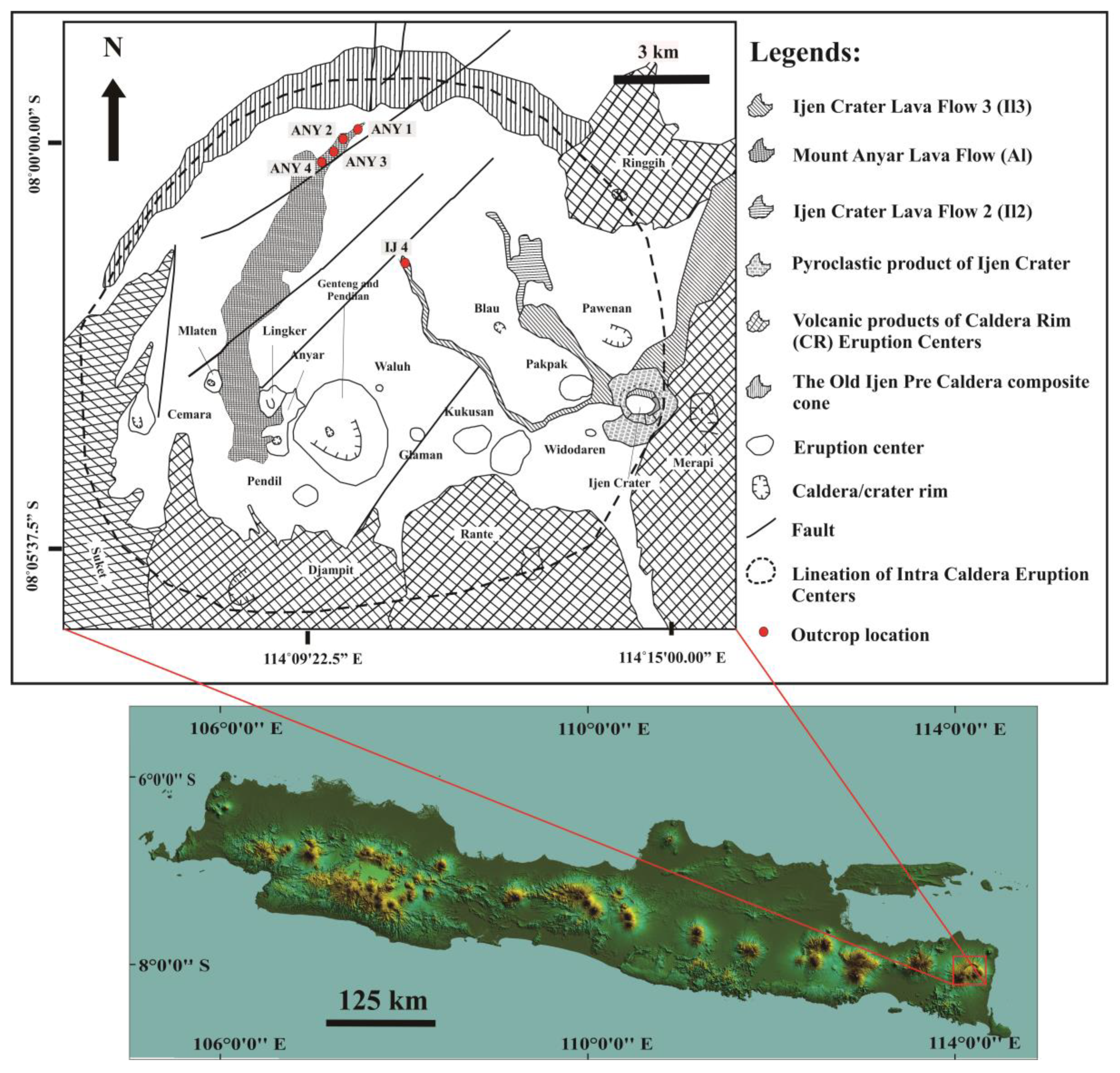
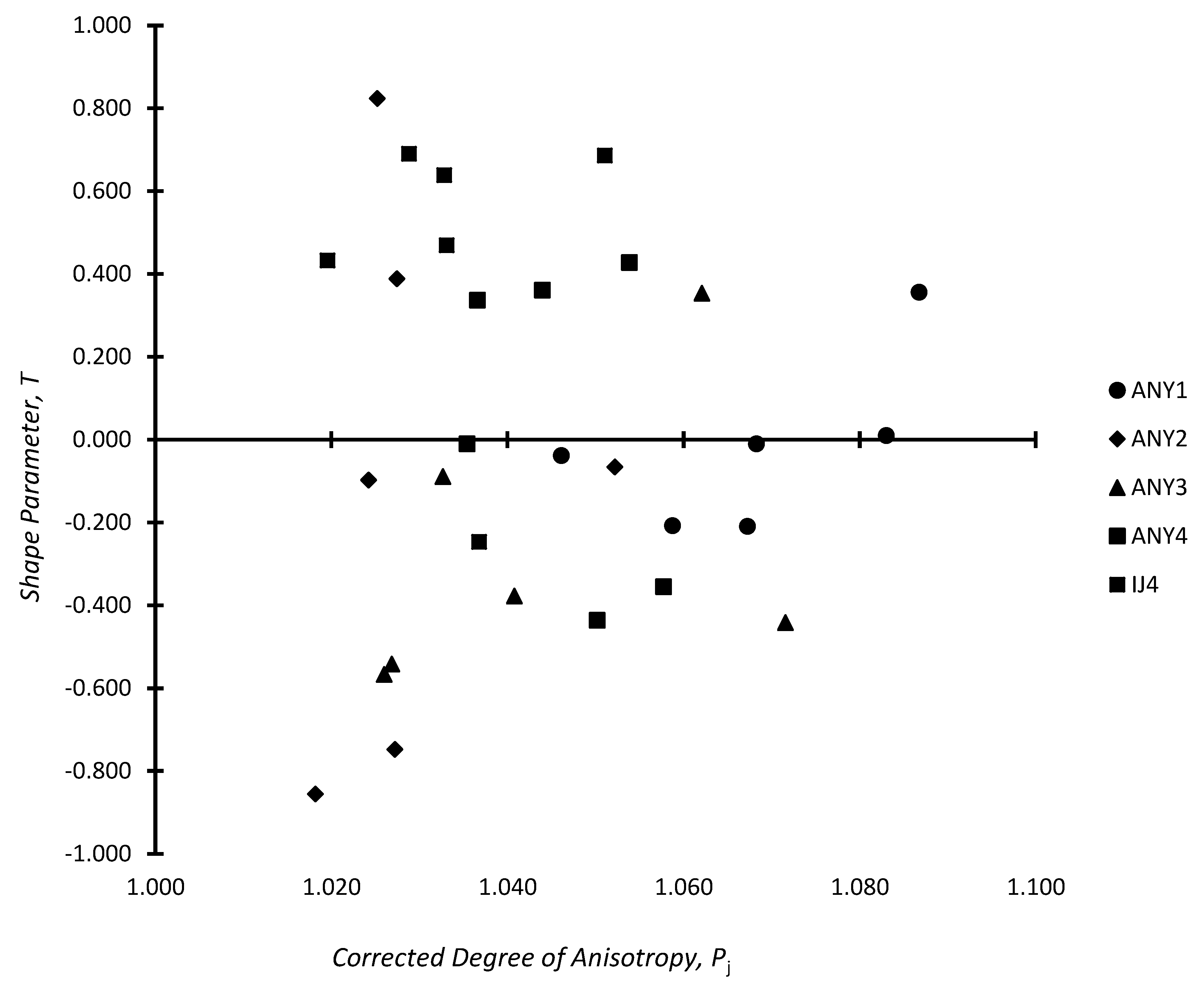
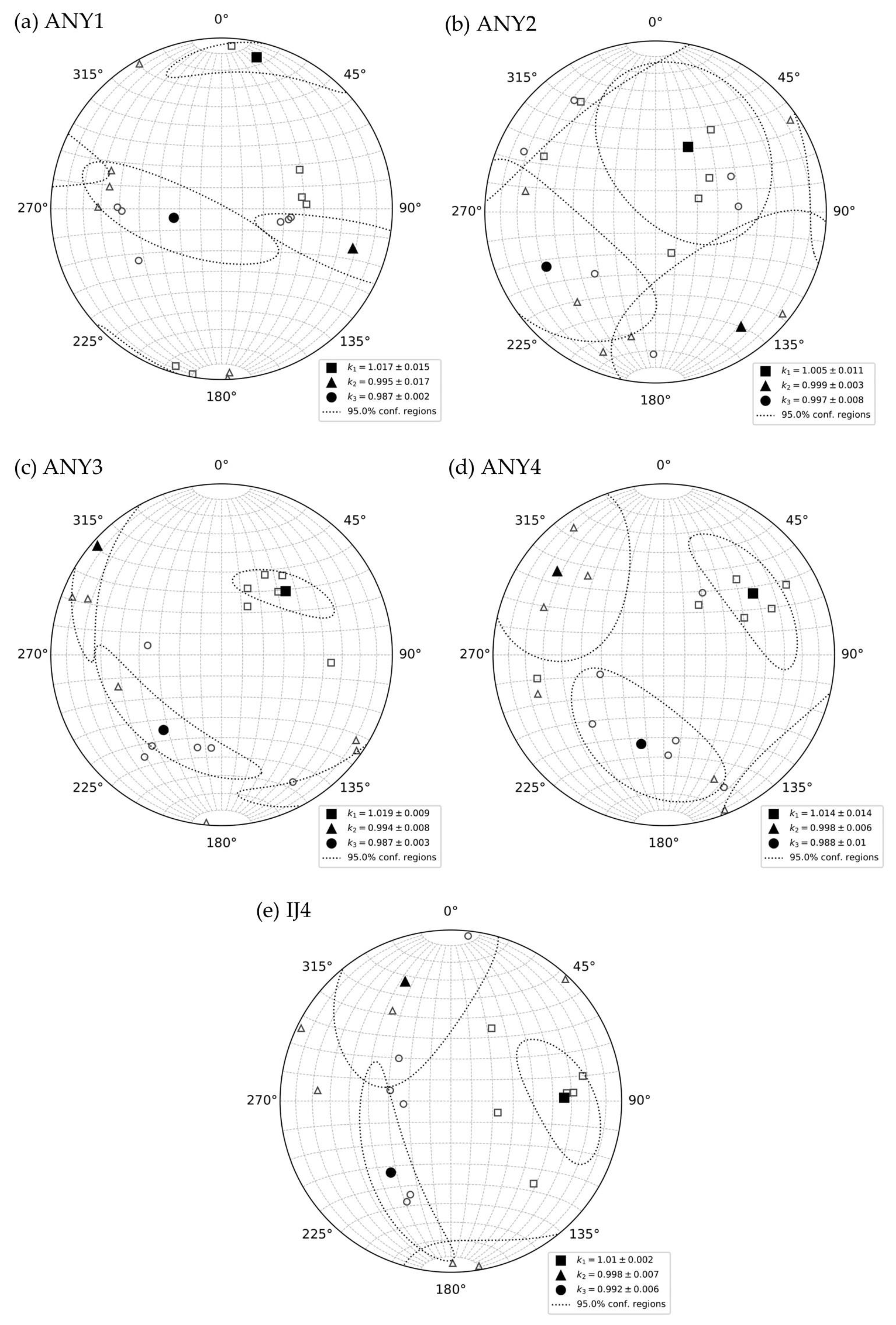
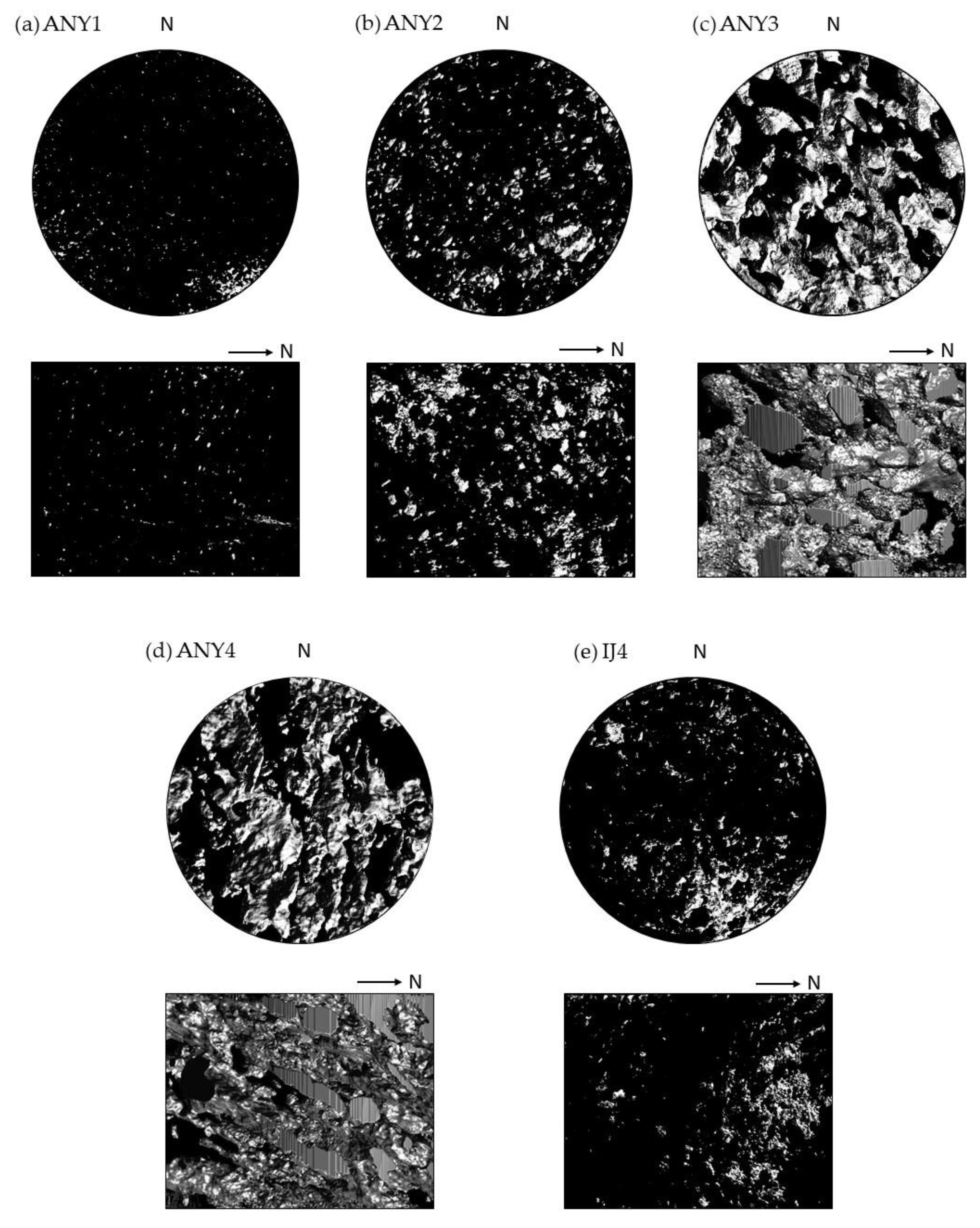
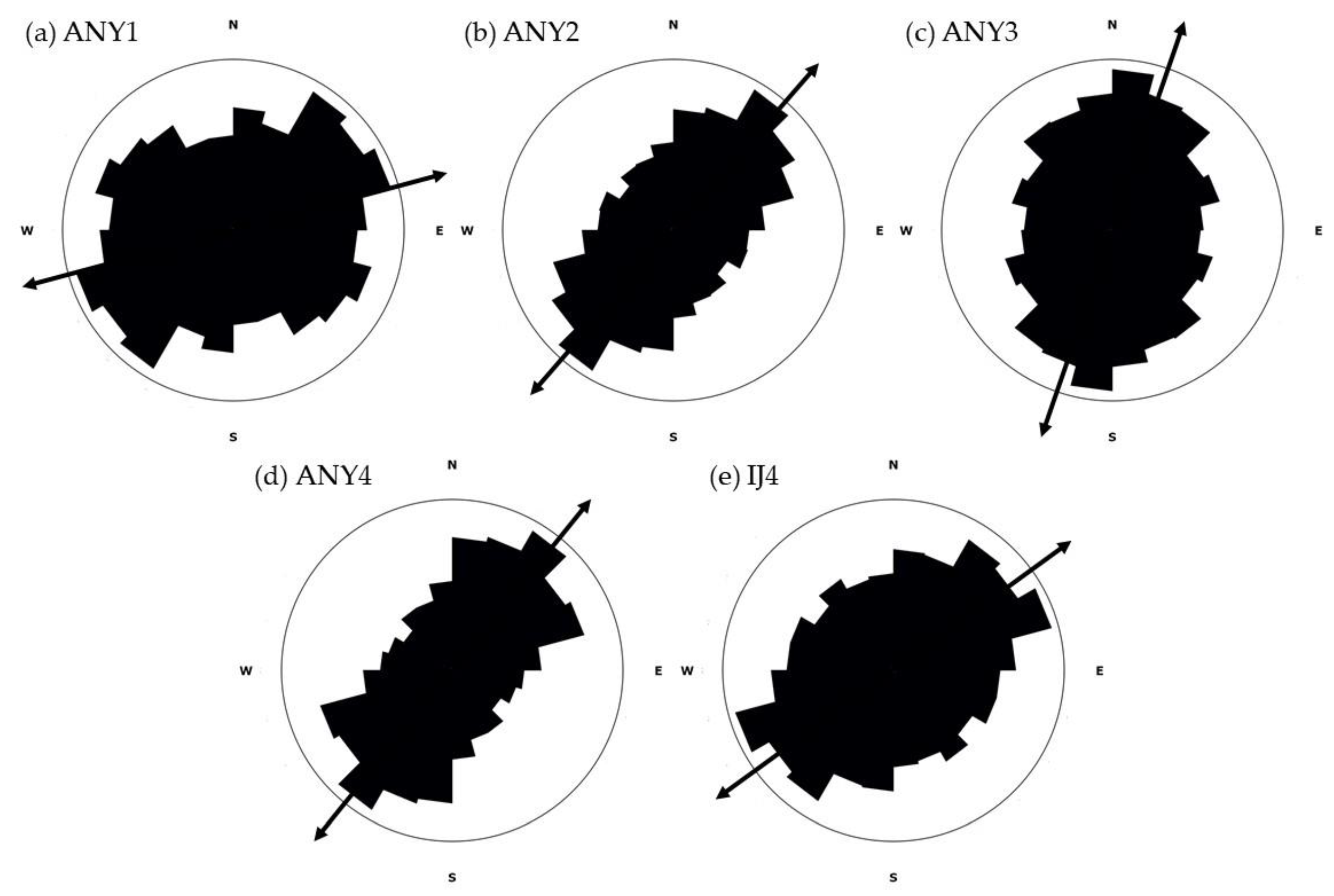
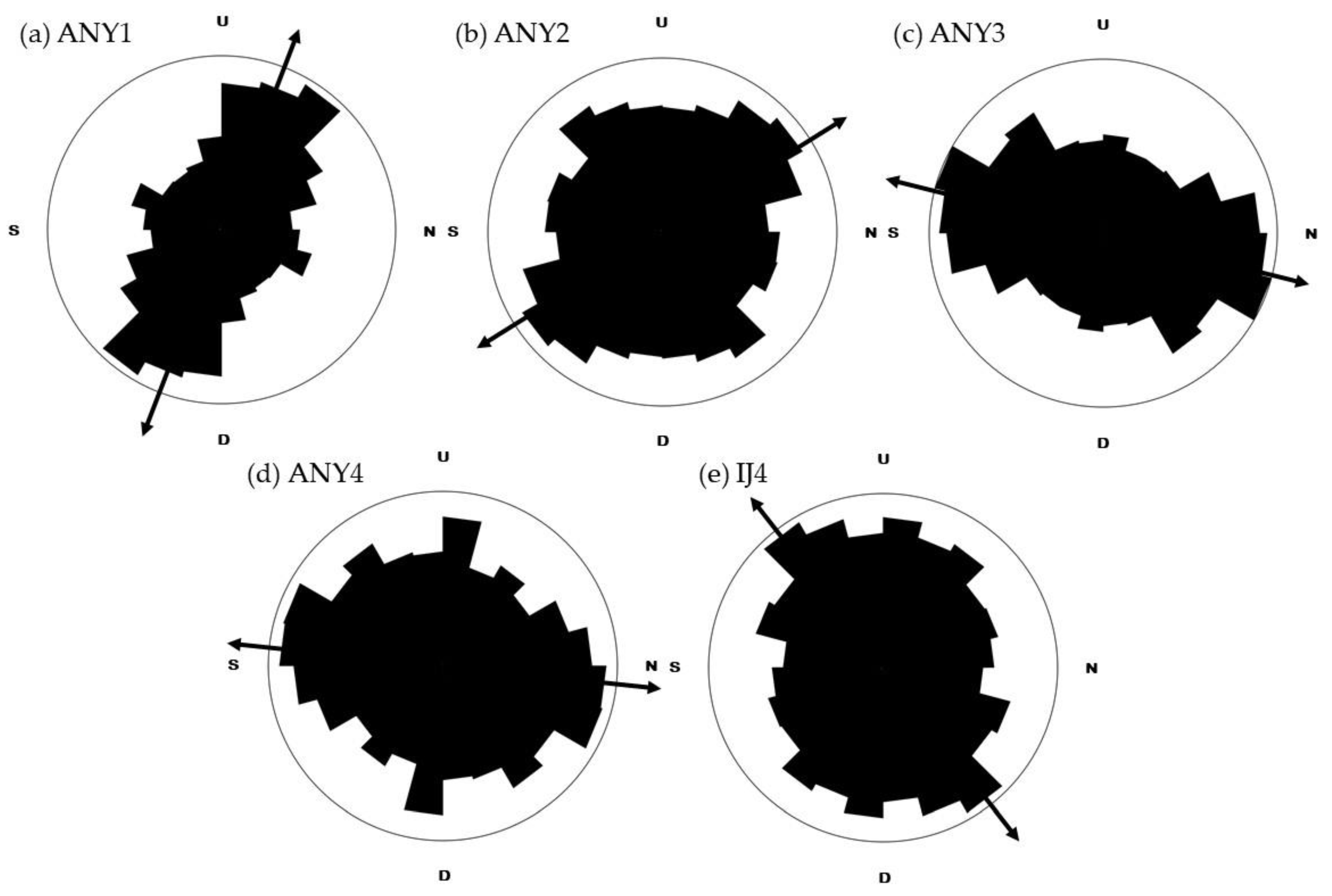
| Sample | IJ4 | ANY1 | ANY2 | ANY3 | ANY4 |
|---|---|---|---|---|---|
| Source | Ijen Crater | Mt. Anyar | Mt. Anyar | Mt. Anyar | Mt. Anyar |
| Lithology | Andesite Basaltic | Basalt | Basalt | Basalt | Basalt |
| Opaque mineral (%) | 8 | 8 | 6 | 7 | 6 |
| Predominant grain shape of opaque mineral | Subhedral, Granular | Subhedral, Prismatic | Subhedral, Prismatic | Subhedral, Prismatic | Subhedral, Prismatic |
| Vesicular/Porosity (%) | 2 | 4 | 12 | 12 | 15 |
| Saturation Field IRM (mT) | 140 | 240 | 340 | 350 | 337 |
| Curie Temperature (Tc) (°C) | - | - | - | ~350 and ~550 | - |
| Mrs/Ms | 0.20 | 0.31 | - | 0.30 | 0.26 |
| Hcr/Hc | 2.81 | 1.78 | - | 1.21 | 1.98 |
| Predominant Magnetic mineral | Titano-magnetite | Titano-magnetite | Titano-Magnetite | Titano-magnetite | Titano-magnetite |
| Predominant Magnetic Domain | PSD | PSD | PSD | PSD | PSD |
| Sample | Specimen | Km (SI) | T | L | F | Pj | P% | P%mean |
|---|---|---|---|---|---|---|---|---|
| ANY1 | ANY1_1 | 1.624 × 10−5 | −0.038 | 1.024 | 1.022 | 1.046 | 4.611 | 6.790 |
| ANY1_2 | 1.572 × 10−5 | −0.208 | 1.035 | 1.023 | 1.059 | 5.831 | ||
| ANY1_3 | 1.590 × 10−5 | −0.209 | 1.040 | 1.026 | 1.067 | 6.678 | ||
| ANY1_4 | 1.595 × 10−5 | 0.010 | 1.040 | 1.041 | 1.083 | 8.302 | ||
| ANY1_5 | 1.571 × 10−5 | −0.010 | 1.034 | 1.033 | 1.068 | 6.830 | ||
| ANY1_6 | 1.578 × 10−5 | 0.356 | 1.027 | 1.057 | 1.087 | 8.491 | ||
| ANY2 | ANY2_1 | 0.954 × 10−5 | 0.823 | 1.002 | 1.021 | 1.025 | 2.275 | 2.786 |
| ANY2_2 | 0.918 × 10−5 | −0.066 | 1.027 | 1.024 | 1.052 | 5.218 | ||
| ANY2_3 | 0.903 × 10−5 | 0.389 | 1.008 | 1.019 | 1.027 | 2.679 | ||
| ANY2_4 | 1.980 × 10−5 | −0.856 | 1.015 | 1.001 | 1.018 | 1.629 | ||
| ANY2_5 | 2.024 × 10−5 | −0.098 | 1.013 | 1.011 | 1.024 | 2.419 | ||
| ANY2_6 | 2.007 × 10−5 | −0.748 | 1.022 | 1.003 | 1.027 | 2.497 | ||
| ANY3 | ANY3_1 | 1.403 × 10−5 | −0.567 | 1.019 | 1.005 | 1.026 | 2.468 | 4.213 |
| ANY3_2 | 1.140 × 10−5 | −0.089 | 1.018 | 1.015 | 1.033 | 3.261 | ||
| ANY3_3 | 1.329 × 10−5 | −0.542 | 1.020 | 1.006 | 1.027 | 2.563 | ||
| ANY3_4 | 1.300 × 10−5 | 0.353 | 1.019 | 1.041 | 1.062 | 6.078 | ||
| ANY3_5 | 1.148 × 10−5 | −0.378 | 1.027 | 1.012 | 1.041 | 3.982 | ||
| ANY3_6 | 1.140 × 10−5 | −0.442 | 1.049 | 1.019 | 1.072 | 6.928 | ||
| ANY4 | ANY4_1 | 1.154 × 10−5 | 0.337 | 1.012 | 1.024 | 1.037 | 3.590 | 4.528 |
| ANY4_2 | 1.130 × 10−5 | 0.428 | 1.015 | 1.037 | 1.054 | 5.223 | ||
| ANY4_3 | 1.220 × 10−5 | 0.361 | 1.014 | 1.029 | 1.044 | 4.302 | ||
| ANY4_4 | 0.954 × 10−5 | −0.010 | 1.018 | 1.017 | 1.035 | 3.541 | ||
| ANY4_5 | 0.894 × 10−5 | −0.436 | 1.035 | 1.013 | 1.050 | 4.862 | ||
| ANY4_6 | 0.933 × 10−5 | −0.356 | 1.038 | 1.018 | 1.058 | 5.652 | ||
| IJ4 | IJ4_1 | 1.019 × 10−5 | −0.247 | 1.023 | 1.014 | 1.037 | 3.640 | 3.204 |
| IJ4_2 | 1.046 × 10−5 | 0.687 | 1.007 | 1.040 | 1.051 | 4.739 | ||
| IJ4_3 | 9.709 × 10−5 | 0.638 | 1.005 | 1.025 | 1.033 | 3.076 | ||
| IJ4_4 | 0.962 × 10−5 | 0.470 | 1.008 | 1.023 | 1.033 | 3.194 | ||
| IJ4_5 | 0.896 × 10−5 | 0.433 | 1.005 | 1.014 | 1.020 | 1.897 | ||
| IJ4_6 | 0.913 × 10−5 | 0.690 | 1.004 | 1.023 | 1.029 | 2.675 |
| Sample | Direction of Mean Principal Susceptibility Axes | |||||
|---|---|---|---|---|---|---|
| K1 | K2 | K3 | ||||
| Dec (°) | Inc (°) | Dec (°) | Inc (°) | Dec (°) | Inc (°) | |
| ANY1 | 13 | 10 | 107 | 21 | 259 | 67 |
| ANY2 | 27 | 55 | 143 | 17 | 243 | 29 |
| ANY3 | 45 | 46 | 311 | 4 | 218 | 44 |
| ANY4 | 55 | 37 | 308 | 22 | 194 | 45 |
| IJ4 | 88 | 34 | 339 | 26 | 220 | 45 |
| Sample | Porosity Percentage | |
|---|---|---|
| µCT (%) | Thin-Slice (%) | |
| ANY1 | 1.8 | 4 |
| ANY2 | 12.8 | 12 |
| ANY3 | 13.4 | 12 |
| ANY4 | 15.1 | 15 |
| IJ4 | 2.5 | 2 |
| Sample | Preferred Pore Orientation | Angle between Preferred Pore Orientation and Susceptibility Axes | |||
|---|---|---|---|---|---|
| Dec (°) | Inc (°) | K1 (°) | K2 (°) | K3 (°) | |
| ANY1 | 75 | 69 | 71 | 52 | 46 * |
| ANY2 | 41 | 32 | 25 * | 89 | 65 |
| ANY3 | 199 | 14 | 64 | 68 | 34 * |
| ANY4 | 219 | 6 | 71 | 52 | 46 * |
| IJ4 | 234 | 52 | 90 | 78 | 12 * |
© 2019 by the authors. Licensee MDPI, Basel, Switzerland. This article is an open access article distributed under the terms and conditions of the Creative Commons Attribution (CC BY) license (http://creativecommons.org/licenses/by/4.0/).
Share and Cite
Atarita, F.R.; Bijaksana, S.; Ndari, N.R.D.W.; Pratama, A.; Taqwantara, R.F.; Fajar, S.J.; Latief, F.D.E. Anisotropy of Magnetic Susceptibility and Preferred Pore Orientation in Lava Flow from the Ijen Volcanic Complex, East Java, Indonesia. Geosciences 2019, 9, 304. https://doi.org/10.3390/geosciences9070304
Atarita FR, Bijaksana S, Ndari NRDW, Pratama A, Taqwantara RF, Fajar SJ, Latief FDE. Anisotropy of Magnetic Susceptibility and Preferred Pore Orientation in Lava Flow from the Ijen Volcanic Complex, East Java, Indonesia. Geosciences. 2019; 9(7):304. https://doi.org/10.3390/geosciences9070304
Chicago/Turabian StyleAtarita, Fadhli Ramadhana, Satria Bijaksana, Nuresi Rantri Desi Wulan Ndari, Aditya Pratama, Reyhan Fariz Taqwantara, Silvia Jannatul Fajar, and Fourier Dzar Eljabbar Latief. 2019. "Anisotropy of Magnetic Susceptibility and Preferred Pore Orientation in Lava Flow from the Ijen Volcanic Complex, East Java, Indonesia" Geosciences 9, no. 7: 304. https://doi.org/10.3390/geosciences9070304
APA StyleAtarita, F. R., Bijaksana, S., Ndari, N. R. D. W., Pratama, A., Taqwantara, R. F., Fajar, S. J., & Latief, F. D. E. (2019). Anisotropy of Magnetic Susceptibility and Preferred Pore Orientation in Lava Flow from the Ijen Volcanic Complex, East Java, Indonesia. Geosciences, 9(7), 304. https://doi.org/10.3390/geosciences9070304






